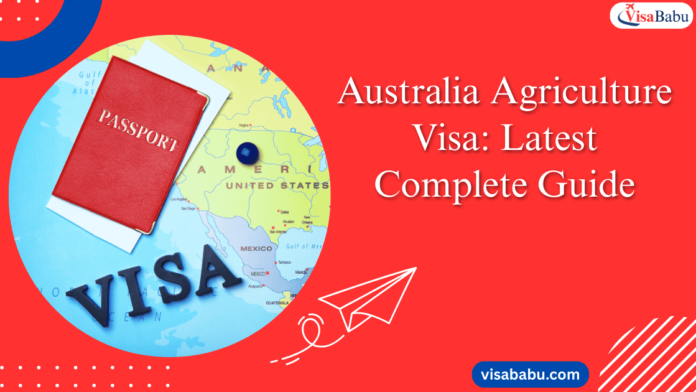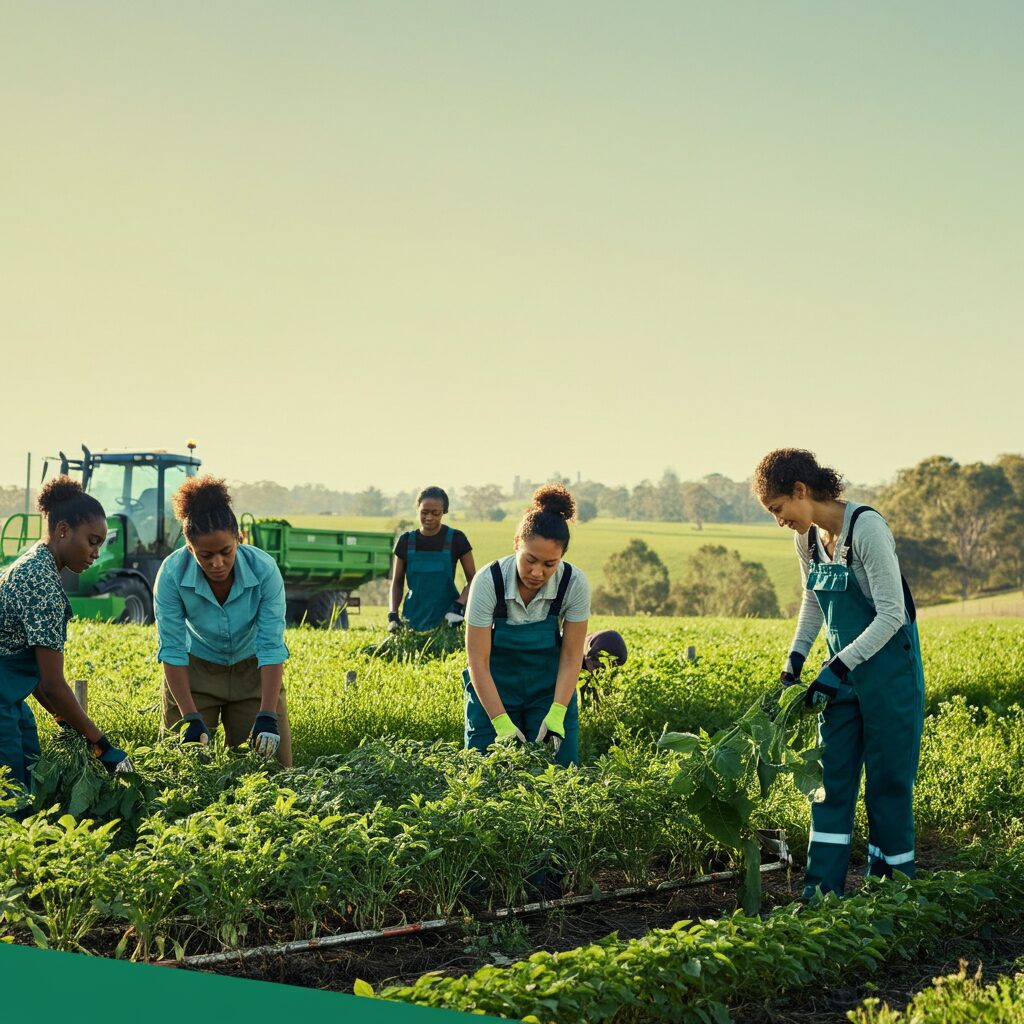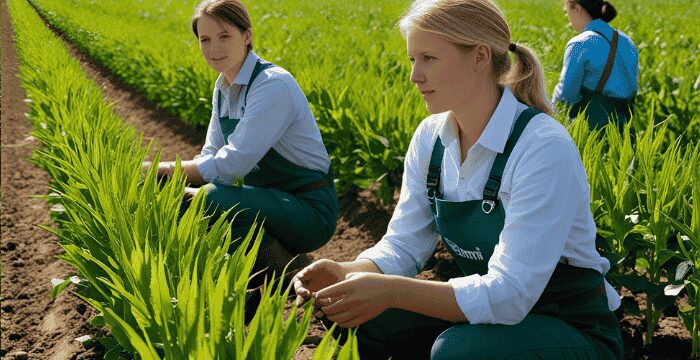The country aims to fill vacant positions in its agricultural industry through the Australia agriculture visa program. On August 23, 2021, the Australian Federal Government created an agricultural visa as their solution to address labor shortages in farming across the country. Employers and potential applicants need updated details about the Australia agriculture visa for 2025 operations.
Latest Facts and News About Australia Agriculture Visa
- The Australian Agriculture Visa was announced by the Federal Government on August 23, 2021, to address workforce shortages in the agricultural sector.
- The visa is designed as a long-term contribution to Australia’s labor supply, supporting agricultural and primary industry sectors in their goal to reach $100 billion in value by 2030.
- It is a stream of the Temporary Work (International Relations) subclass 403 visa.
- The Department of Foreign Affairs and Trade (DFAT) manages the program, leveraging its experience with the Pacific Labour Scheme.
- The visa program targets workers from specific countries, with an initial focus on ASEAN nations and the UK, though bilateral agreements are still being negotiated.
What is the Australia Agriculture Visa?
The Australia agriculture visa aims to solve industry shortages by letting foreign workers fill open jobs in Australian farms. The agriculture visa system brings foreign workers to Australia to fill jobs in many types of farming, including horticulture, meat handling, dairy production, fibre production, grain farming, fishing enterprises, and plant harvesting.
Our government combines these new programs with the Pacific Labour Scheme and Seasonal Worker Program to bring reliable workers into Australian farms. The program is important due to the COVID-19 pandemic, which limited international seasonal workers from entering Australia to help produce food.
The New Agricultural Visa Australia program provides better options to agriculture employers and includes additional job opportunities beyond the Temporary Skill Shortage 482 visa
Eligibility Criteria for the Australia Agriculture Visa
Age Requirements
Applicants must be 21 years old or older when they apply for the Australia agriculture visa with no upper age restriction. Workers under 21 cannot apply because Australia wants workers who can handle working life experience effectively.
Nationality Requirements
The visa operates only for a defined list of nations to start the program. Only Pacific region nations such as Timor-Leste, Fiji, Kiribati, Nauru, Papua New Guinea, Samoa, Solomon Islands, Tonga, Tuvalu, and Vanuatu currently participate in the program. The program will grow to serve ASEAN members and British workers through official agreements that continue to develop between countries.
According to new updates, the visa information given in the Terratern resources shows that Indonesia, Thailand, Vietnam, Malaysia, and Philippines residents are now accepted.
Skills and Experience
An applicant who seeks agricultural work must have the exact skills needed for that position. The requirement helps ensure that new workers start their agricultural roles in Australia with the needed expertise to benefit the industry. Job skills differ according to which part of agricultural work an employee needs to perform.
Language Proficiency
All candidates need to show where their English language performance meets the required level of 4.0 on average through IELTS or equivalent14. Workers who must communicate advanced knowledge details must have advanced language skills to perform specific jobs. The language requirement helps protect workers by enabling discussions and makes it easier for them to join local rural communities during their stay.
Additional Requirements
- Jobseekers need to fulfil multiple extra application conditions.
- Only workers without family can become applicants.
- Newcomers to Australia must show their physical and moral qualities before entering the country.
- Everyone who wants to stay in Australia must buy proper health insurance coverage for the entire period they are here.
- Initial applications must be completed offshore
Application Process for the Australia Agriculture Visa in 2025
Sponsorship Requirements
Foreign workers seeking an Australia agriculture visa must fulfil these specific steps:
- They must receive formal support from DFAT for their employment under the Pacific Labour Scheme.
- Visa processing requires an employer who meets all government requirements.
- DFAT endorses my participation in the Pacific Labour Scheme.
- An approved Temporary Activities Sponsor
Legitimate employers with suitable work conditions can hire foreign agricultural staff because of sponsorship requirements.
Document Collection
To apply successfully, applicants must prepare several necessary documents:
- Valid passport
- Employment contract
- Proof of English language proficiency
- Evidence of work experience
- Medical certificates
Having complete necessary documents ready makes the application process go faster and decreases the chance of problems.
Application Submission
The application process involves:
- Online submission through the Australian Department of Home Affairs’ ImmiAccount portal
- Payment of the visa application fee (AUD $315)14
- Depending on the visa application type, you need an additional interview
DFAT Endorsement
The Department of Foreign Affairs and Trade performs Pacific Labour Scheme evaluations and creates endorsement numbers for visa applications. The Department of Foreign Affairs and Trade endorsement is the main requirement that must always be obtained first.
Benefits of the Australia Agriculture Visa For Indians in 2025
| Category | Benefits / Outcomes |
|---|
| For Workers (Indians) | – Ability to take up farm jobs in Australia’s farmlands with standard pay rates and proper workforce rules. |
| – Potential pathway to permanent residency in Australia. |
| – Skill development and gaining international work experience. |
| – Opportunities for cultural exchange. |
| – Helps workers build better lives while developing skills. |
| For Australian Agriculture | – Addresses critical workforce shortages in various agricultural sectors. |
| – Supports industry targets to create $100 billion in value by 2030. |
| – Provides consistent employment resources to meet industry needs. |
| – Maintains productivity during peak farming seasons. |
| – Addresses labour shortage issues highlighted by the 2024 Ausveg report: 46% of farmers struggle to find workers; labour costs make up 38-71% of production expenses. |
| For the Australian Economy | – Supports economic growth in regional areas. |
| – Ensures the agriculture industry has enough farmers and exporters to sustain operations. |
| – Encourages the government to strengthen international relationships with participating countries. |
| – Aims to create a better employment framework in agriculture. |
For Workers
- The Australia agriculture visa helps foreign workers receive several important advantages.
- Workers can take up farm jobs in Australia’s farmlands while enjoying standard pay rates and proper workforce rules.
- Potential pathway to permanent residency in Australia
- Skill development and international work experience
- Cultural exchange opportunities
Foreign workers see this visa as an excellent path to develop their skills while building better lives in Australia.
For Australian Agriculture
The Australian agricultural industry has had multiple beneficial outcomes through this visa program.
- Addresses critical agricultural workforce shortages across various sectors
- The visa system helps achieve industry targets to create $100 billion in value before 2030.
- The program offers consistent employment resources for industry needs.
- Helps maintain productivity during peak seasons
The program works best at fixing the labour shortages that business sector reports show today. The 2024 Ausveg sentiment report shows that 46% of farmers have trouble finding workers, while labour costs account for 38% of production expenses, up to 71% in extreme situations.
For the Australian Economy
The broader economic benefits include:
- Supporting economic growth in regional areas
- The industry requires sufficient farmers and exporters to operate its operations.
- The government should work to build better relationships with all countries that take part in the program.
- Our plan is to build a better way to employ people in agriculture.
Sectors and Occupations Covered
| Category | Details |
|---|
| Agricultural Sectors | – Horticulture |
| – Meat processing |
| – Dairy |
| – Wool |
| – Grains |
| – Fisheries (including aquaculture) |
| – Forestry |
| – Agricultural support services and primary processing |
| Enables primary industry sectors across Australia to hire workers through this program. |
| Skill Levels | – Skilled workers |
| – Semi-skilled workers |
| – Low-skilled workers |
| Example Occupations | – Horticulture Grower |
| – Horticulture Farm Manager |
| – Production Horticulturist |
| – Facility Supervisor |
| – Truck Driver |
| – Forklift Driver |
| – Nurseryperson |
| – Machinery Manager |
| – Quality Assurance Manager |
| Recruitment Approach | – Initial recruitment focuses on workers for simple tasks |
| – Later phases will expand the program to include more occupations and skill levels |
Agricultural Sectors
The Australia agriculture visa permits workers to fill various job needs spanning different sectors.
- Horticulture
- Meat processing
- Dairy
- Wool
- Grains
- Fisheries (including aquaculture)
- Forestry
- Agricultural support services and primary processing
The wide scope of industries enables primary industry sectors across Australia to hire workers through this program.
Skill Levels and Occupations
The program serves workers at different expertise levels.
- Skilled workers
- Semi-skilled workers
- Low-skilled workers
Specific occupations may include:
- Horticulture Grower
- Horticulture Farm Manager
- Production Horticulturist
- Facility Supervisor
- Truck Driver
- Fork Lift Driver
- Nurseryperson
- Machinery Manager
- Quality Assurance Manager
During the first period, recruitment aims to find workers for simple tasks, and later phases will expand the program further.
Challenges and Considerations in Australia Agriculture Visa For Indians 2025
Language Barriers
Workers have difficulty communicating in the workplace because they struggle with the English language. Clear English communication skills help visa holders work better and become part of the community, which motivates the minimum IELTS rule.
Visa Conditions and Limitations
Several criteria restrict visa rights and obligations.
- Workers cannot bring family members
- People must begin their visa application from outside Australia.
- Visa holders have to keep enough health insurance coverage.
- The migrant workers may work only within the government-approved agricultural industries.
- The government has implemented these rules to solve the farming labour shortage while controlling the program.
Implementation Timeline
The program will be activated over three years and will build up gradually. The program grows step by step, so changes can be made throughout development.
During Phase 1 recruitment, only a few countries and approved employers from the Pacific Australian Labour Mobility (PALM) scheme joined the process. The initial start-up of the visa system happens with trusted expert approval holders who have already dealt with this scheme.
Comparison with Other Agricultural Work Visas for Australia in 2025
Pacific Australia Labour Mobility (PALM) Scheme
Through the PALM scheme, Australian workers with new agricultural visas find a successful path to temporary employment during Australian harvest seasons. The Australia agriculture visa will work alongside existing programs rather than eliminate them to provide more choices for employers and employees.
Working Holiday Maker Program
Part of the Australia agriculture visa program emerged from changes made to Working Holiday Makers because of the new UK-Australia Free Trade Agreement, which eliminated the work farm requirements needed by UK backpackers to extend their visas1.
Temporary Skill Shortage (TSS) Visa
Agricultural employers find more practical solutions when choosing the Australia agriculture visa instead of the Temporary Skill Shortage 482 visa program.
Future Developments and Pathways to Permanent Residency
Expansion Plans
As time passes, the government intends to expand the program by adding new options.
The government wants to bring more nations into this agreement through formal agreements between countries
The program will accept more types of professional work from overseas applicants.
Developing a demand-driven approach to recruitment1
The proposed growth strategies will assist the program in meeting the new requirements of Australian farmers.
Permanent Residency Pathways
The program assesses paths to becoming permanent residents along with regional living opportunities. The long-term permanent residency options will be set up and activated over three years to create lasting opportunities for visa holders.
Regional Settlement
The government-location strategy puts agricultural workers where the sector needs them most to develop rural communities. The program helps farming businesses hire labour while building rural populations for declining areas.
Conclusion
The Australia agriculture visa presents an important new solution to help Australia find enough workers for farms. Through its specialised visa program, the government enables Australian agriculture to grow long-term while hiring workers from specific countries with various skills.
Despite being a work in progress till 2024, this visa scheme benefits farm operators and foreign agricultural workers. The visa program becomes more attractive and powerful for the nation’s future farming industry by providing a clear direction to becoming an Australian permanent resident.
Before deciding on a visa, applicants must fully check eligibility terms and all the steps needed for the application. The Australian agricultural sector finds this program important because it solves their workforce shortage challenge and keeps their sector prosperous. Visit VisaBabu for the latest updates and news about immigration news and updates.
Frequently Asked Questions
Q1. Officials first declared the Australian Agriculture Visa on August 23, 2021.
On August 23, 20211, the Federal Government revealed the Australian Agriculture Visa to the public for the first time.
Q2. Can family members support their dependents when they work under the Agricultural Visa?
The Australian Agriculture Visa program rules deny participants from bringing their families to Australia.
Q3. What level of English must visa applicants demonstrate during evaluation?
The Australian Agriculture Visa needs IELTS scores of at least 4.0, yet some jobs need better English language skills.
Q4. For how many months can workers stay in Australia through this visa?
Businesses seeking seasonal or long-term workers can provide opportunities to employees for up to 9 months or between one year to 3 years. Seasonal employees can use their visas to work in Australia for up to four consecutive years without repeat visa applications.
Q5. What charge must employees pay to apply for the Agriculture Visa?
Visa applicants need to pay a total charge of AUD $31514.








